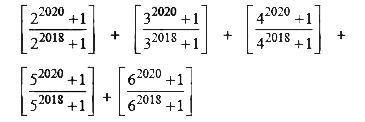Let [x] be the greatest integer less than or equal to x, for a real number x. Then the equation [x2]=x+1 has
two solutions
one solution
no solution
more than two solutions
The correct Answer is:C
Step by step video, text & image solution for Let [x] be the greatest integer less than or equal to x, for a real number x. Then the equation [x^2]=x+1 has by Maths experts to help you in doubts & scoring excellent marks in Class 12 exams.
Topper's Solved these Questions
- BOOK - KVPY PREVIOUS YEARCHAPTER - QUESTION PAPER 2020EXERCISE - PART-II : MATHEMATICS7videos
QUESTION PAPER 2020
- BOOK - KVPY PREVIOUS YEARCHAPTER - QUESTION PAPER 2020EXERCISE - PART-I (MATHEMATICS)20videos
QUESTION PAPER 2020
- BOOK - KVPY PREVIOUS YEARCHAPTER - QUESTION PAPER 2013EXERCISE - PART-II ( MATHEMATICS)10videos
QUESTION PAPER 2013
- BOOK - KVPY PREVIOUS YEARCHAPTER - SOLVED PAPER 2018EXERCISE - EXAMPLE27videos
SOLVED PAPER 2018
Similar Questions
Knowledge Check
- Question 1 - Select One
Let [x] be the greatest integer less than or equal to x, for a real number x. Then the following sum

is-A80B85C90D95 - Question 2 - Select One
Let [x] denote the greatest integer less than or equal to x for any real number x. then limx→∞[n√2]n is equal to
A0B2C√2D1 - Question 3 - Select One
If [x] denotes the greatest integer less than or equal to x for any real number x. Then, limx→∞[n√2]n is
A0B2C√2D1
If [x] denotes the greatest integer less than or equal to x, then the solutions of the equation 2x-2[x]=1 are
View SolutionLet [x] denote the greatest integer less than or equal to x. Then, ∫−11[x]dx=?
View SolutionLet [x] denote the greatest integer less than or equal to x. Then, ∫1.50[x]dx=?
View SolutionLet [x] denotes the greatest integer less than or equal to x if x=(√3+1)5then [x] is equal to
View SolutionLet [x] denotes the greatest integer less than or equal to x. If f(x)=[xsinπx], then f(x) is
View Solution
